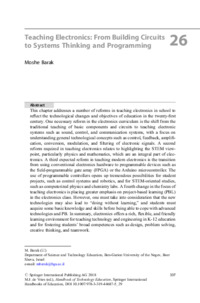Teaching Electronics: From Building Circuits to Systems Thinking and ProgrammingMoshe Barak
|
 |
 Diese Seite wurde seit 8 Jahren inhaltlich nicht mehr aktualisiert.
Unter Umständen ist sie nicht mehr aktuell.
Diese Seite wurde seit 8 Jahren inhaltlich nicht mehr aktualisiert.
Unter Umständen ist sie nicht mehr aktuell.
 Zusammenfassungen
Zusammenfassungen
 This chapter addresses a number of reforms in teaching electronics in school to reflect the technological changes and objectives of education in the twenty-first century. One necessary reform in the electronics curriculum is the shift from the traditional teaching of basic components and circuits to teaching electronic systems such as sound, control, and communication systems, with a focus on understanding general technological concepts such as control, feedback, amplification, conversion, modulation, and filtering of electronic signals. A second reform required in teaching electronics relates to highlighting the STEM viewpoint, particularly physics and mathematics, which are an integral part of electronics. A third expected reform in teaching modern electronics is the transition from using conventional electronics hardware to programmable devices such as the field-programmable gate array (FPGA) or the Arduino microcontroller. The use of programmable controllers opens up tremendous possibilities for student projects, such as control systems and robotics, and for STEM-oriented studies, such as computerized physics and chemistry labs. A fourth change in the focus of teaching electronics is placing greater emphasis on project-based learning (PBL) in the electronics class. However, one must take into consideration that the new technologies may also lead to 'doing without learning,†and students must acquire some basic knowledge and skills before being able to cope with advanced technologies and PB. In summary, electronics offers a rich, flexible, and friendly learning environment for teaching technology and engineering in K-12 education and for fostering students´ broad competences such as design, problem solving, creative thinking, and teamwork.
This chapter addresses a number of reforms in teaching electronics in school to reflect the technological changes and objectives of education in the twenty-first century. One necessary reform in the electronics curriculum is the shift from the traditional teaching of basic components and circuits to teaching electronic systems such as sound, control, and communication systems, with a focus on understanding general technological concepts such as control, feedback, amplification, conversion, modulation, and filtering of electronic signals. A second reform required in teaching electronics relates to highlighting the STEM viewpoint, particularly physics and mathematics, which are an integral part of electronics. A third expected reform in teaching modern electronics is the transition from using conventional electronics hardware to programmable devices such as the field-programmable gate array (FPGA) or the Arduino microcontroller. The use of programmable controllers opens up tremendous possibilities for student projects, such as control systems and robotics, and for STEM-oriented studies, such as computerized physics and chemistry labs. A fourth change in the focus of teaching electronics is placing greater emphasis on project-based learning (PBL) in the electronics class. However, one must take into consideration that the new technologies may also lead to 'doing without learning,†and students must acquire some basic knowledge and skills before being able to cope with advanced technologies and PB. In summary, electronics offers a rich, flexible, and friendly learning environment for teaching technology and engineering in K-12 education and for fostering students´ broad competences such as design, problem solving, creative thinking, and teamwork. Dieses Kapitel erwähnt ...
Dieses Kapitel erwähnt ...
 Anderswo finden
Anderswo finden
 Volltext dieses Dokuments
Volltext dieses Dokuments
 |  Teaching Electronics: From Building Circuits to Systems Thinking and Programming: Artikel als Volltext bei Springerlink ( Teaching Electronics: From Building Circuits to Systems Thinking and Programming: Artikel als Volltext bei Springerlink ( : :  , 904 kByte; , 904 kByte;  : :  ) ) |
 Anderswo suchen
Anderswo suchen 
 Beat und dieses Kapitel
Beat und dieses Kapitel
Beat hat Dieses Kapitel während seiner Zeit am Institut für Medien und Schule (IMS) ins Biblionetz aufgenommen. Er hat Dieses Kapitel einmalig erfasst und bisher nicht mehr bearbeitet. Beat besitzt kein physisches, aber ein digitales Exemplar. Eine digitale Version ist auf dem Internet verfügbar (s.o.). Aufgrund der wenigen Einträge im Biblionetz scheint er es nicht wirklich gelesen zu haben. Es gibt bisher auch nur wenige Objekte im Biblionetz, die dieses Werk zitieren.











 Biblionetz-History
Biblionetz-History